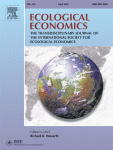Ver ítem
- xmlui.general.dspace_homeCentros Regionales y EEAsCentro Regional Salta - JujuyEEA SaltaArtículos científicosxmlui.ArtifactBrowser.ItemViewer.trail
- Inicio
- Centros Regionales y EEAs
- Centro Regional Salta - Jujuy
- EEA Salta
- Artículos científicos
- Ver ítem
Can't see the forest for the trees: can declining deforestation trends in the Argentinian Chaco Region be ascribed to efficient law enforcement?
Resumen
A national “Forest Law” passed in Argentina in 2007 mandated provincial governments to set up and implement
land use planning processes in order to protect their native forests and regulate the expansion of large-scale
agriculture. A recent study postulates that observed reductions in deforestation in three provinces of the
Argentinian “Dry Chaco” ecoregion (namely Salta, Santiago del Estero, and Chaco) can be attributed to the
effective enforcement
[ver mas...]
A national “Forest Law” passed in Argentina in 2007 mandated provincial governments to set up and implement
land use planning processes in order to protect their native forests and regulate the expansion of large-scale
agriculture. A recent study postulates that observed reductions in deforestation in three provinces of the
Argentinian “Dry Chaco” ecoregion (namely Salta, Santiago del Estero, and Chaco) can be attributed to the
effective enforcement of this law by provincial governments. Yet a more contextualized analysis of the local
situation raises a number of objections to the methods used and the conclusions drawn in that study. Our analysis
(and first-hand experience) shows that provincial governments were unable to enforce the Forest Law, since
deforestation in protected areas continued or even increased after its approval and implementation. Our criticism
can be categorized into five major challenges: (1) declining deforestation trends started before the Forest
Law; (2) a province with a substantial increase in deforestation was omitted; (3) only part of one ecoregion was
taken into account in the analysis; (4) deforestation percentage by conservation categories is better than hectares
by province as an indicator of law enforcement; and (5) assigning zones to land units prior to land use planning
processes is questionable. These challenges, and the lack of a more complete and nuanced political analysis of
the situation on the ground, calls into question both the reliability of the results and the usefulness of the
conclusions in the study. Ambiguous or misleading messages from the academic community can have negative
political consequences and hinder local conservation efforts in the short term. We should not be so caught up in
our desire to see improvements on the ground that we can't see the forest for the trees.
[Cerrar]

Autor
Volante, Jose Norberto;
Seghezzo, Lucas;
Fuente
Ecological economics 146 : 408–413. (2018)
Fecha
2018
Editorial
Elsevier
ISSN
0921-8009
Formato
pdf
Tipo de documento
artículo
Palabras Claves
Derechos de acceso
Restringido
 Excepto donde se diga explicitamente, este item se publica bajo la siguiente descripción: Creative Commons Attribution-NonCommercial-ShareAlike 2.5 Unported (CC BY-NC-SA 2.5)
Excepto donde se diga explicitamente, este item se publica bajo la siguiente descripción: Creative Commons Attribution-NonCommercial-ShareAlike 2.5 Unported (CC BY-NC-SA 2.5)

